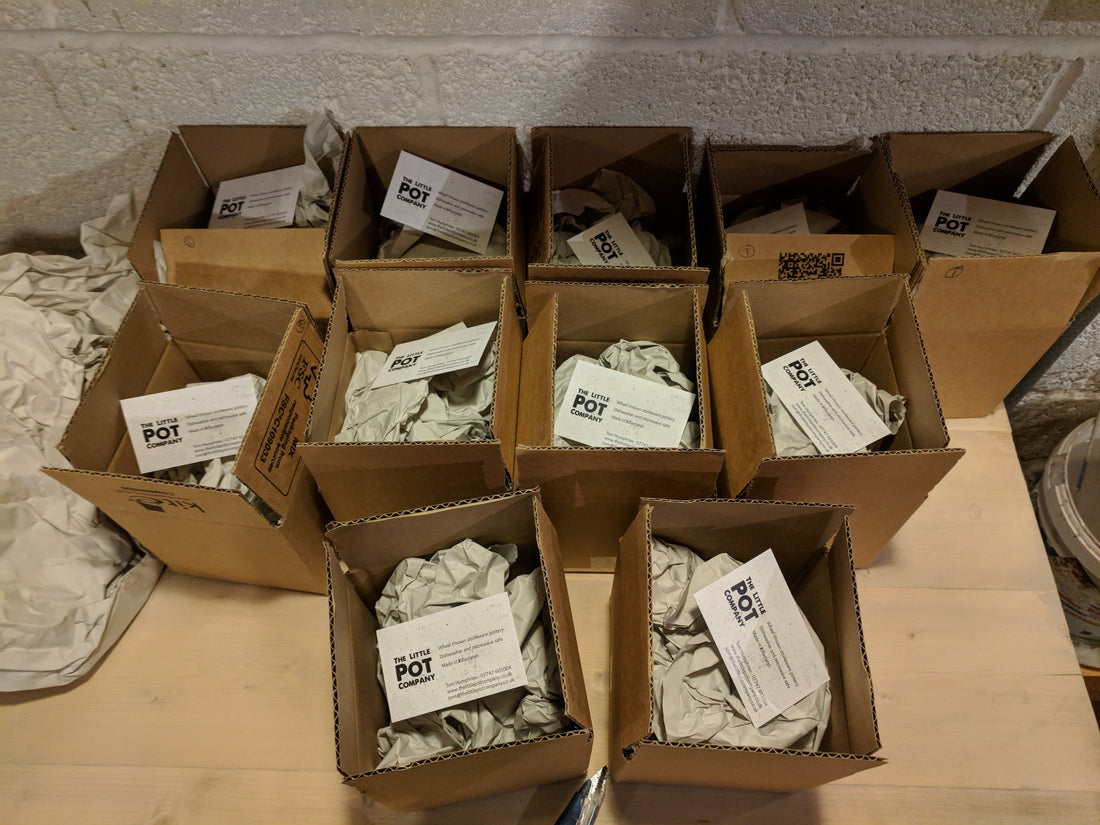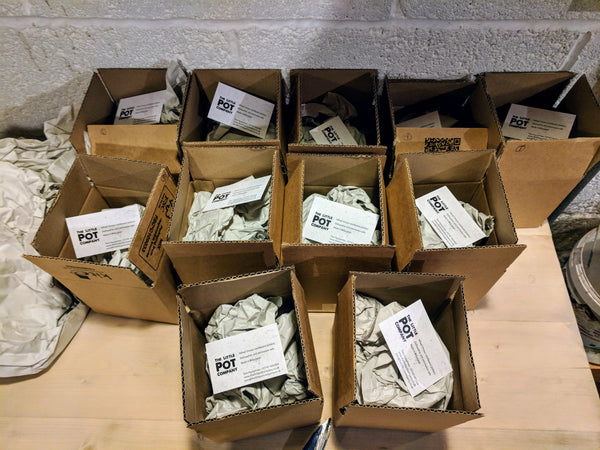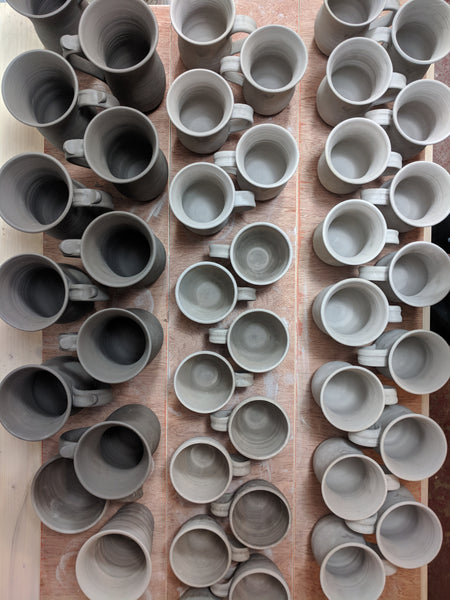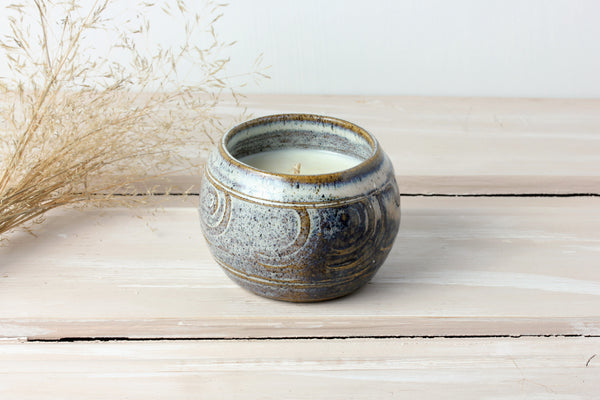
How to Start Selling Your Handmade Pottery Online
Share
You may have come here from my previous blog post about equipment and tools for pottery beginners. If not, you may find that article useful when setting up your studio.
This post is aimed at people who have started making pottery and feel they are ready to start offering it to the world. There is only so much shelf space for all those mugs!
I’m not currently a full time potter but I do make regular trips to the post office with parcels of pottery to send out into the world. I started making pots around 5 years ago, mainly just in the evenings and in the last few months I’ve started working one full day a week in my studio.
I’ve been quite obsessive, and while I’m sure I’ll look back at what I’m making now with disgust at some point, I think I’ve come a long way since the first pots I made.
There are many ways to sell pottery offline from craft fairs to galleries and gift shops. I’m just going to talk about online selling here as that’s where I have the most experience.
I’m going to break down your plan of action into these key areas:
- What online platform to sell on
- Logo, branding, graphic design
- How to market your pottery - social media, mailings lists, blogging, paid adverts
- Packaging, sourcing and how to wrap
- Photography - equipment, types of shot
- Making yourself seem legitimate - customer reviews, copy writing, returns policy
Where to sell your pottery online

There are two ways to go when selling crafts online, either you go it alone on your own website or use a craft platform like Etsy, Folksy or Not On The Highstreet.
The first sales I ever made were on Etsy and I think this site is a good place to start.
Selling on Etsy / Folksy etc
Pros
- It's very easy to setup a profile, and with a few product photos you can create a listing in no time.
- You will get some traffic to your products just from people browsing through the site.
- Good way to test your products. If you are selling things, maybe move to your own site. If not maybe work on your products more or photography and descriptions.
Cons
- When I started out I don’t remember there being that many paid advertisers on there. It seems now nearly all the top listings are paid adverts.
- The fees are fairly high, I wrote an article about the total Etsy fees a while ago as this wasn't very clear to me until I dug into it.
After testing my products on Etsy, and becoming a bit miffed with their fees I decided to move to my own website. I currently use Shopify to manage the website. There are many other ecommerce providers you could look into but I’ve been pretty happy with Shopify.
I have some coding experience that has allowed me to make changes, but there are templates built in so you don’t need any coding experience. There is a free trial period you could have a look at it, and see if it suits your needs.
Do you like podcasts? I think they're a great way to learn while driving or doing other things where you can't look at a screen or book. My favourite is the Unofficial Shopify Podcast. It's a great free resource and most of the shows would work with any website, not just Shopify specifically.
Whatever solution you have for your website there are pro and cons of going it alone.
Selling on your own website
Pros
- You can display your pottery however you like, alter the backgrounds, have unlimited images
- More control over shipping policies and other technical details
- Add blog content and other pages for promotions
- Unlimited listings without fees for each product listing
- Integrate your paying customers with mailing list software such as Mailchimp
Cons
- It’s a lot of work keeping things up to date
- Certain amount of technical expertise needed, or willing to learn
- Depending on how much you sell, the monthly payments may be more than fees on Etsy or other sites
- There is no free traffic. You need to work very hard to get visitors through advertising, social media, blog posts or other promotion
Creating a Logo and Brand for your pottery company
Once you have decided where you might sell your pottery online, you need to decide how to brand yourself. I see broadly three schools of thought here, either it’s the persons name ‘Joe Bloggs Ceramics’, location specific ‘Winchcomb Pottery’, or some random clay related mash up like ‘The Little Pot Company’. I started life as ‘Woodseats Pottery’ but when I moved from Woodseats I felt I had to change the name, so maybe avoid that unless you’re sure you'll never move!
Once you have your name you will need a logo. Mine is very simple, I did it myself just by choosing a font I felt was suitable and arranging it in free graphics software such as Inkscape.
I know it isn’t amazing and I may get a graphic designer to do a new one at some point. If you can’t afford a designer I suggest keeping it very simple. Remember it may be viewed very small on phone screens and should be readable as a profile icon on Facebook and Instagram.
Many brands use taglines to show what values they hope to convey. Whether you use a tagline or not, it may be a good idea to think about what style of pottery your brand is representing. Are you an artist, a production potter, or something else? How do you see your pottery being used, and how is your target customer going to perceive your brand? Would people aspire to own one of your pieces, or is it affordable enough for them to buy multiple items and grow their collection?
How to market your pottery business online

Whether you plan to setup your own website or use a service like Etsy, you will need to get a large amount of traffic to get any sales.
Even with the most in interested customers visiting your page the conversion rate is unlikely to be over 2%. For blog traffic or social media referrals this is likely to be a lot lower.
Getting traffic from social media
There's so many social media platforms it’s hard to be everywhere. I've chosen to focus on Instagram and Facebook for now. I imagine Pinterest would be great for pottery too but I've never managed to get my head around how it works properly.
To start on Facebook you will need a page dedicated to your business. Once you have asked all your friends to Like it, you can try posting on Facebook groups to spread the word.
There are tonnes of groups that pottery would suit, try searching 'handmade’, 'handcrafted’ and 'craft’. The posts in these groups need to be well crafted to get any interest. I've found posting things such as 'follow this link to buy my pottery’ don't really work. Instead ask a question 'what do you think I could do differently with this design?’ or 'which is your favourite out of these colours?’.
By getting people to comment and like your posts, they will stay higher in the group feed and be more visible. On the same post you need to link either to your Facebook page, or to your website to make it worthwhile.
I've only recently started on Instagram and was approaching it totally wrong to start with. Recently I've started to get some traction and have made some sales directly from free Instagram referrals. There's quite a lot to say on the subject so I decided to write a guide about it which can be downloaded below.
Using mailing lists to drive traffic
I was pretty confused by mailing lists when I first heard of them. Why would you want to spend your time writing emails to a load of people you don’t know? Well, here a some reasons why they’re great…
- Unlike Facebook or Instagram followers, if you have somebody's email address, you can contact them indefinitely. Imagine if you had spent hundreds of hours getting thousands of MySpace fans, and then suddenly no-one uses MySpace.
- People signing up to your mailing list have already shown some interest in your company so will be easier to pitch your products to.
- Most mailing list providers such as Mailchimp or Klaviyo have free plans up to a certain amount of subscribers. Just make sure whoever you choose, you can export your list if you choose to switch provider at a later date.
- There’s a tonne of automation options, such as follow up emails when customers place an order. These things are hard to keep track of manually when a few orders are coming in.
Of course people don’t like giving their email address away willy nilly. There has to be some kind of incentive - perhaps a discount, giveaway or some kind of valuable information. Also make it clear they can unsubscribe and get off the list at any time.
Using a pottery blog or other content to attract customers
Can you string a few sentences together? If so maybe writing about your work could attract some customers. I’ve never been a great writer, I got told off at school for not writing enough! Running a small business requires many hats though, and without funds to hire copywriters I’ve had to bash the keys myself. It gets easier the more you do it.
I’ve found that it’s better to spend ages writing one big in depth post, rather than many little update type posts. My article about beginners pottery equipment drove 1401 visitors to my site last month. Most of those just read it and go away, but some click through to product pages or join my mailing list.
Getting traffic from paid adverts
I've done a little experimenting with Facebook adverts. The first time I tried it I didn't get any sales. It was a very small spend on ads - I think about £15 total, but I stopped them because I felt I was wasting money. Perhaps it was a bad product, image or description.
I decided to try again once a pot was selling without adverts and seemed popular with my social media followers. In the last month or so I ran a couple of adverts for my heart mugs and scented candles which people seem to like. Again it was a very small ad spend but I sold a few at around £3 advert cost per pot sale.
I think my product and images were better this time, and probably having more reviews on my site helped with sales.
I also probably targetted my adverts better. Facebook allows you to show the ads to people with specific interests such as pottery & ceramics, and target age ranges, locations and loads of other stuff.
From what I have read Facebook, Instagram and Google adverts are the best options at the moment for online advertising. Hopefully I will be able to improve my advertising skills and reduce the cost of each sale in the future.
If you're interested in having a go with Facebook ads just search out the Ads Manager. It's really easy to get started and you can set a daily budget so you don't end up spending a load.

Packaging and wrapping pottery for website sales
I’ve spent quite a lot of time looking for packaging suppliers, and my current choice is Kite Packaging, based in the UK. I’m in the process of switching to totally recyclable packaging, and they supply paper bubble wrap and paper sticky tape.
One thing I would never do again is buy single walled boxes. The only breakages I’ve ever had have been with single wall boxes, even though I used loads of bubble wrap. The strength difference between single and double wall boxes is considerable. You could probably stand on a double wall box and it wouldn’t collapse, whereas a single wall one certainly would.
I also bought a load of 5” x 5” boxes for mugs, but 6” x 6” is much safer to have a good layer of protection. I like to include the printed receipt in the box along with a business card with a hand written thank you. You could also put some freebies like sweets or something in there.
Photography for selling your pottery online
If you are serious about getting good images of your pottery you will have to ditch the camera phone. I know it may have as many megapixels as a proper camera, and with all the filters at first sight it might look impressive. The one thing they lack is a decent lens. For ages I struggled with my camera phone, wondering why my pots looked all distorted, especially when close up. I’m sure you notice often when you do a selfie close up your face looks weird - the same effect that it gives your pottery.
It did use my phone when starting to sell things on Etsy, and things did sell. If you can’t afford a camera the most important thing is to use natural light to your advantage. Set up your photo shoot near a window and turn off the house lights. Don’t get too close to avoid distortion, and steady yourself or use a phone mini tripod to avoid blurring.
I bought an old Canon 550D on eBay for a couple of hundred quid, with Yongnuo flash and umbrella setup from Amazon. This allows me to photograph when the world is in darkness - that is when I’m most active!
I recently read about it being very important to have the two main types of photos on your product page. The first type being the product photo - plain shot from various angles on plain background. The second type is a lifestyle photo - somebody using your pottery or it placed in a scene with lots of props to show how it would fit into everyday life.
I’m planning to do a big lifestyle shoot once I have convinced Helen to model for me. I think they can convey a lot to your audience about how the products might make them feel.
How to seem trustworthy when selling your pottery
I know I’m the most trustworthy person you can ever meet. The other day I went to buy some bubble wrap from an industrial estate. The lady in the office got confused with the cash and accidentally undercharged me £10. I told her about her mistake because I’m honest and she would’ve probably got in trouble when the petty cash was wrong.
Anyone visiting my website wouldn’t know any of this. So how to I convince them to send me money via Paypal or enter their Card Details? If you are selling on Etsy or similar sites there is a certain amount of added confidence - these are big companies that want to look after their buyers. For independent sites I see three key areas for building confidence.
- Security and site design. All major ecommerce providers should be doing things like SSL (padlocked) checkouts. Hopefully they will also provide a simple intuitive checkout process. Much of this will probably not be under your control, but you can control a lot of the site design. Make sure your images are not so large your site takes forever to load. Carousel images a notoriously bad for homepage load speeds, especially when stuff with massive image files. Make sure your product copy writing is professional.
- Customer reviews are absolutely essential. It’s the first thing most people look for when deciding to buy or not. As a new business obviously you won’t have any, but you must go all out to get them. Follow up all purchases with a request for a review, and if anyone emails you praising something you sold them, ask if you can add that as a review.
- Make yourself clearly available for any questions. Add your phone number, nobody will probably ring but it’s good to know they could. Write a clear explanation of the shipping process, returns policy and what happens if something breaks. I’m happy for anyone to send things back for a full refund, thankfully nobody has yet.
Did all that make sense?
I'm not sure if I bombarded you with too much information. If so, just concentrate on your pottery making, take some good photos and stick them on Etsy. It's quite a lot of work setting up your own website, mine is still a work in progress after a year or so. Rome wasn't built in a day and all that.
Please leave a comment below or email me with any questions and I'll do my best to help out.


7 comments
Thanks so much this is all very clear and encouraging but it still takes bravery. I have Jospots Facebook, jospottery Instagram and Etsy and I’d really like to change the name before starting a website but fear loosing the followers I have….it all boggles the mind but I love what I do so can’t complain! 💙
this was extremely helpful 🙏 thank you!!
Thank you for the article . It was to the point. Clear and informative.
Thank you so much to share your experience, it is a great inspiration. Good luck!!
Thanks for sharing your experience with the world, you are brave. I am also a hobby Potter 3 years now, will have to start selling…. Do not have space anymore. 🌺